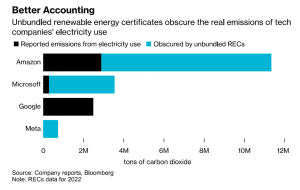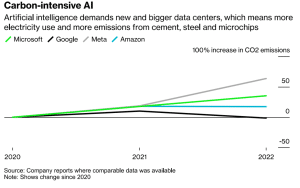Tech companies are increasingly adopting artificial intelligence (AI) technologies, but this surge in AI comes at a significant environmental cost, especially carbon footprint, that many of these companies are obscuring, according to a Bloomberg Green analysis. Major players like Amazon, Microsoft, and Meta are using unbundled renewable energy certificates (RECs) to make their operations appear greener than they actually are.
Smokescreen RECs? How They Distort Big Tech’s Green Claims
Earlier this month, the Integrity Council for the Voluntary Carbon Market (ICVCM) announced that carbon credits issued under existing renewable energy methodologies will no longer qualify for its Core Carbon Principles designation. This ruling impacts about 32% of the voluntary carbon market, translating to about 236 million carbon credits.
The ICVCM’s decision reflects a shift in focus towards more stringent standards to ensure that carbon credits represent real, additional, and verifiable emission reductions. This move is expected to influence the market significantly, particularly for projects relying on existing renewable energy methodologies.
Per Bloomberg analysis, RECs allow companies to claim that their energy consumption is more environmentally friendly, even if they are still relying on fossil fuels. This practice significantly distorts the true carbon footprint of these tech giants.
Microsoft, for instance, reported that its carbon emissions have increased by 30% since 2020, despite the company’s goal to become carbon negative. Microsoft and other tech firms have attributed this rise in emissions to the carbon-intensive materials used in building data centers, such as cement, steel, and microchips.
They claim that the energy required for AI is largely sourced from zero-carbon resources like wind and solar power. However, experts argue that these claims are misleading and do not reflect the reality of energy consumption. Some said that there is no physical basis for the claim that AI is powered entirely by clean energy.
- CHECK THIS OUT: US Data Center Power Use Will Double by 2030 Because of AI
The Carbon Accounting Crisis
In 2022, Amazon, Microsoft, and Meta relied heavily on these unbundled RECs to report lower emissions. That is despite the fact that these carbon credits do not result in actual reductions in atmospheric greenhouse gasses.
The use of unbundled RECs is permitted under current carbon accounting rules, but many experts believe these rules are outdated and do not accurately reflect real-world emissions. If companies like Amazon and Microsoft did not use these carbon credits, their reported emissions would be significantly higher.

Take this example: Amazon’s 2022 emissions would be 8.5 million metric tons higher than reported, which is three times what the company disclosed. Similarly, Microsoft’s emissions would be 3.3 million tons higher, and Meta’s reported footprint could increase by 740,000 tons.
Some tech companies have recognized the flaws in using unbundled RECs and have moved away from them. Google, for instance, phased out its use of these credits several years ago after acknowledging that they do not lead to real emissions reductions. Instead, Google focuses on purchasing clean energy directly and aims to achieve carbon-free energy consumption on an hourly and location-specific basis.
Amazon, on the other hand, relied on unbundled RECs for 52% of its renewable energy in 2022. This makes the tech giant the most dependent on these instruments among the major tech companies. The company has stated that it plans to reduce its reliance on unbundled RECs as more of its directly contracted renewable energy projects come online.
Meta, which used unbundled RECs for 18% of its renewable energy in 2022, claims that the majority of its renewable energy efforts are focused on projects that would not have been built otherwise.
Microsoft has also announced plans to phase out the use of unbundled RECs in the future.
AI vs. Climate Goals
Microsoft’s ambitious goal to become carbon negative by 2030 faces significant challenges as its push for AI has led to a 30% increase in carbon emissions since 2020. The company’s president, Brad Smith, acknowledges the difficulty in meeting these targets, especially with the explosive growth of AI, which requires energy-intensive data centers built with carbon-heavy materials like steel and concrete. Despite this, Smith believes that AI’s benefits will outweigh its environmental costs.
Microsoft’s AI expansion is driving up electricity consumption, with the company’s energy use rivaling that of small European countries. The tech giant plans to spend over $50 billion on expanding its data centers in the coming year, further increasing its carbon footprint. While Microsoft claims to be 100% powered by renewables, this is achieved largely through the purchase of RECs.

Microsoft’s leadership is aware that meeting its climate goals will require significant investment and innovation. If emissions remain high, the company may resort to purchasing carbon removal credits, though this is not seen as the preferred solution. Brad Smith remains optimistic, emphasizing that climate change is a solvable problem, but it will require sustained effort and investment.
The Global Impact of Big Tech’s Reliance on RECs
Tech companies are the largest buyers of unbundled RECs globally, and their continued use of these carbon credits could have far-reaching implications as more corporations seek to reduce their carbon footprints. The current accounting rules, established under the Greenhouse Gas Protocol, allow companies to use unbundled RECs to report lower emissions. However, these standards are due for an update, and experts are working to propose changes that better reflect actual emissions.
Thus, while tech companies are making bold claims about their efforts to power AI with clean energy, the reality is more complex. The use of unbundled RECs allows the tech giants to obscure the true environmental impact of their operations. This, in turn, raises questions about the effectiveness of current carbon accounting practices and the need for greater transparency in corporate climate reporting.


